Collectors and coin enthusiasts often seek 1945 Wheat Pennies for their historical significance and appeal—especially those in high grades with attractive toning. The value of a 1945 penny depends on several factors including condition, mint mark, and the presence of any rare errors.
Although the average value ranges from 6 cents to $1, rare error varieties can significantly increase a coin’s worth. In fact, one remarkable 1945 penny even sold at auction for $20,400—proving that hidden gems might be out there waiting to be discovered.
1945 Wheat Penny Value Chart
| Condition | 1945 No Mint Mark | 1945 D Penny | 1945 S Penny |
|---|---|---|---|
| Fine | $0.06 | $0.06 | $0.12 |
| Very Fine | $0.12 | $0.12 | $0.18 |
| Extra Fine | $0.23 | $0.23 | $0.23 |
| About Uncirculated (AU) | $0.41 | $0.41 | $0.41 |
| MS 60 | $1.02 | $1.02 | $1.02 |
| MS 63 | $2.41 | $2.41 | $2.41 |
The 1945 Wheat Penny History
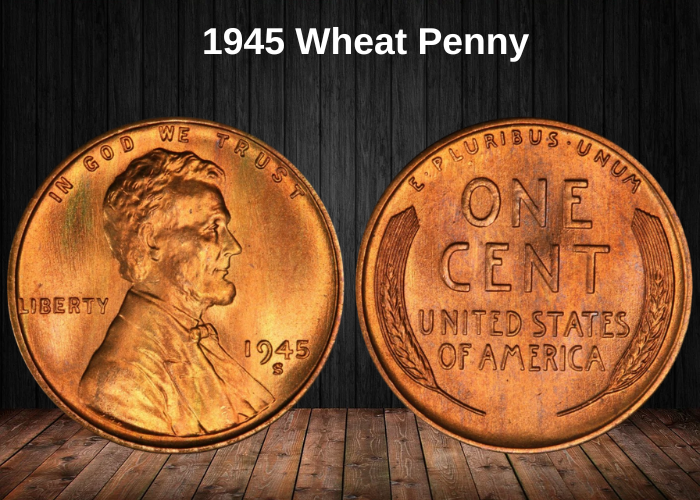
The 1945 Lincoln cents are part of the iconic Wheat Penny series, minted in three U.S. Mints: Philadelphia, San Francisco, and Denver. This beloved series began in 1909 to commemorate the 100th birthday of President Abraham Lincoln, featuring a design by Victor D. Brenner.
The Wheat Penny remained in circulation until 1959, when the reverse design was changed to honor Lincoln’s 150th birthday. Notably, the obverse—featuring Lincoln’s portrait—remained unchanged, marking the first time a real person was depicted on a U.S. coin.
A Coin with Cultural Impact
Lincoln’s popularity made the new penny an instant sensation. In 1909, people lined up for hours just to get their hands on the coin. While the public adored it, vending machine companies were less enthusiastic—the penny’s thickness didn’t fit existing machines. Since the Mint’s Chief Engraver Charles E. Barber refused to alter the design, vending machine manufacturers eventually adapted their machines instead.
Collectibility and Production
Initially, from 1909 to 1935, only regular strikes were issued. But as collector interest grew, proof versions began production in 1936 at the Philadelphia Mint.
1945 Wheat Penny Mintages
| Mint Location | Variety | Mintage |
|---|---|---|
| Philadelphia | 1945 No Mint Mark Penny | 1,040,515,000 |
| San Francisco | 1945 S Penny | 181,770,000 |
| Denver | 1945 D Penny | 266,268,000 |
| Total | 1,488,553,000 |
A Wartime Coin with a Backstory
The 1945 Wheat Penny was minted during the final year of World War II, adding historical weight to its value. Interestingly, rumors suggest that some coins from 1944–1946 may have been struck using recycled ammunition shells left over from military training.
During the war, the U.S. faced a copper shortage, prompting the Mint to briefly switch to zinc-coated steel for the 1943 penny. However, these steel cents rusted easily and were often mistaken for dimes, leading to public frustration. In response, the Mint reverted to the pre-war copper alloy by 1944—a composition that continued through 1945.
Characteristics and Varieties
Despite their unique wartime history, 1945 Wheat Pennies share the same core features as others in the series. They appear in three varieties:
- No mint mark (Philadelphia)
- S mint mark (San Francisco)
- D mint mark (Denver)
These coins are readily available across all grades, even up to Mint State (MS) 65, making them a solid addition to any collection.
The 1945 Wheat Penny Features
The 1945 Wheat Penny obverse
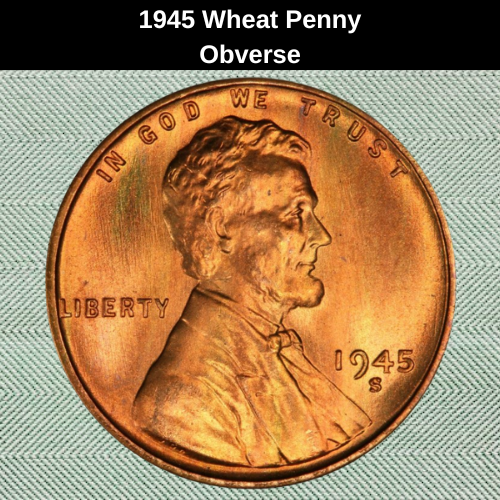
Like other Lincoln pennies, the 1945 Wheat Penny features the iconic profile of President Abraham Lincoln on the obverse. The minting year appears to the right of his portrait, and just below the date, you’ll find the mint mark—if the coin was struck in Denver (D) or San Francisco (S). On the left side, the word “LIBERTY” is clearly visible, while the national motto “IN GOD WE TRUST” arcs gracefully across the top, just above Lincoln’s head.
The 1945 Wheat Penny reverse
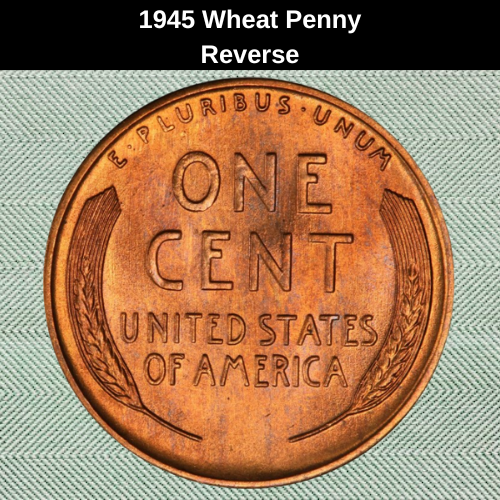
The reverse of the 1945 Lincoln Wheat Penny displays two stylized wheat ears, one along each rim—giving the coin its famous “Wheat Penny” nickname. Nestled between the wheat stalks are four lines of inscriptions:
- ONE
- CENT
- UNITED STATES
- OF AMERICA
Above these words, you’ll find the Latin motto “E PLURIBUS UNUM” gracefully arching across the top, completing the symmetrical and symbolic design.
1945 Wheat Penny Specifications
- Diameter: 19.05 mm (0.75 inches)
- Weight: 3.11 grams (0.1097 ounces)
- Face Value: One cent ($0.01)
- Shape: Round
- Composition: 95% copper with zinc or tin
- Thickness: 1 mm (0.03937 inches)
- Edge: Plain
Other Features of the 1945 Wheat Penny
The 1945 Wheat Penny is a round, plain-edged coin composed of 95% copper, with the remaining 5% typically consisting of zinc or tin. Each coin has a diameter of 19.05 mm (0.75 inches) and weighs approximately 3.11 grams (0.1097 ounces). These pennies are also relatively thin, with a standard thickness of 1 mm (0.03937 inches), giving them the familiar feel and size collectors recognize from the era.
1945 Wheat Penny Grading
Most professional grading companies use a modified version of the Sheldon grading scale to assess a coin’s condition and value. This system, introduced by renowned numismatist Dr. William Sheldon in 1948, provides a standardized method to evaluate coins on a scale from 1 to 70.
Use the following reference to estimate your 1945 Wheat Penny’s grade:
| Grade | Description |
|---|---|
| 1 | Basal State-1 |
| 2 | Fair |
| 3 | Very Fair |
| 4–6 | Good |
| 7–10 | Very Good |
| 12–15 | Fine |
| 20–30 | Very Fine |
| 40 | Extremely Fine |
| 50 | About Uncirculated |
| 60 | Mint State |
| 65 | Gem Mint State |
| 70 | Perfect Mint State |
Before determining the value of your coin, it’s essential to check its grade. Feel free to browse our grading guides for detailed visuals and descriptions to help you accurately identify your coin’s condition.
1945 Wheat Penny Value Guides
In 1945, three U.S. Mints—Philadelphia, Denver, and San Francisco—produced a total of 1,488,553,000 Lincoln Wheat cents through regular strikes. It’s important to note that the U.S. Mint suspended proof coin production from 1942 to 1950 due to World War II. As a result, no proof versions of the 1945 Wheat Penny were ever made, making all surviving pieces circulation strikes.
1945 No Mint Mark Wheat Penny Value
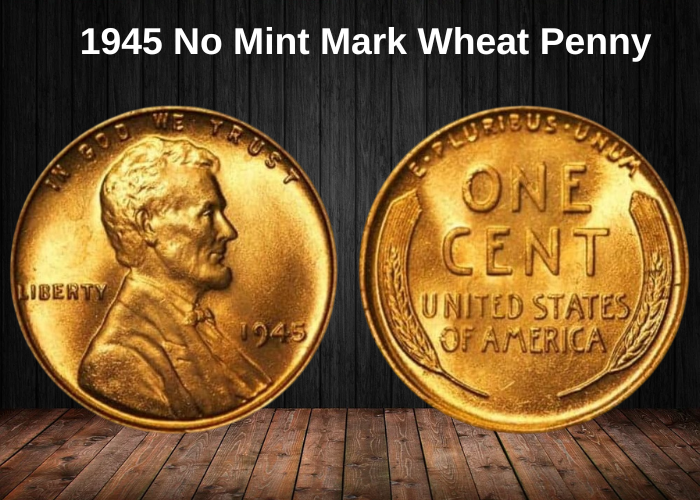
In 1945, the Philadelphia Mint struck 1,040,515,000 Lincoln cents without a mint mark, making them quite common today. As a result, their market value is generally low unless the coin is in exceptional condition.
One of the most important factors that influences the value—besides overall condition—is the coin’s color. Over time, copper coins develop different tones based on exposure to air and handling. These tones are categorized as:
- Brown (BN): typically valued between $0.25 and $45.
- Red-Brown (RB): usually range from $0.35 to $55.
- Full Red (RD): lower-grade pieces sell for $0.55 to $32.40, while higher-grade examples like MS 67 can be worth around $260.
At the top end, MS 68 RD examples are extremely rare and can fetch between $5,000 and $6,000 at auctions or among advanced collectors.
1945 D Wheat Penny Value
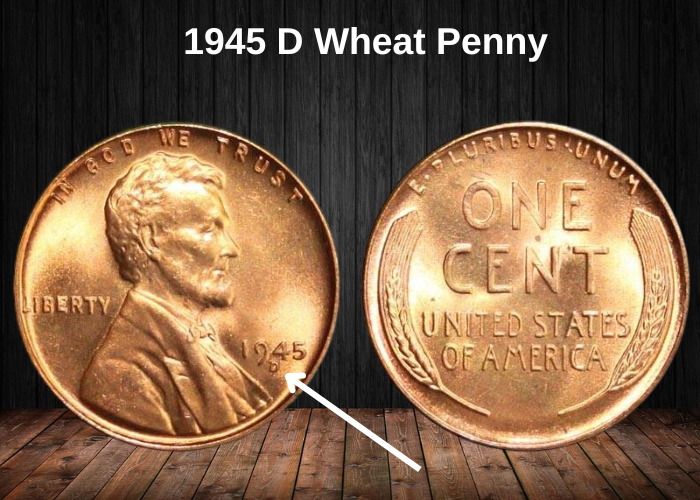
In 1945, the Denver Mint produced 266,268,000 Lincoln Wheat pennies. Like their counterparts from Philadelphia, these coins are available in three different color variations: brown, red-brown, and full red. Here’s how the pricing generally works based on their color and condition:
- Brown (BN) pennies are priced between $0.25 to $45.
- Red-Brown (RB) pennies generally range from $0.35 to $55.
- Full Red (RD) coins tend to be the most valuable, especially those in higher grades.
For uncirculated red Lincoln cents, prices increase significantly based on their preservation level:
- MS 63: Around $1.50
- MS 64: Around $2.50
- MS 65: Between $8 and $10
- MS 66: Between $23 and $30
- MS 67: Between $115 and $138
However, MS 68 examples are extremely rare, and their prices can skyrocket. The price range for these top-tier coins is estimated at $12,000 to $15,000. The highest price paid for one such coin was $14,400 at an auction in 2019.
1945 S Wheat Penny Value
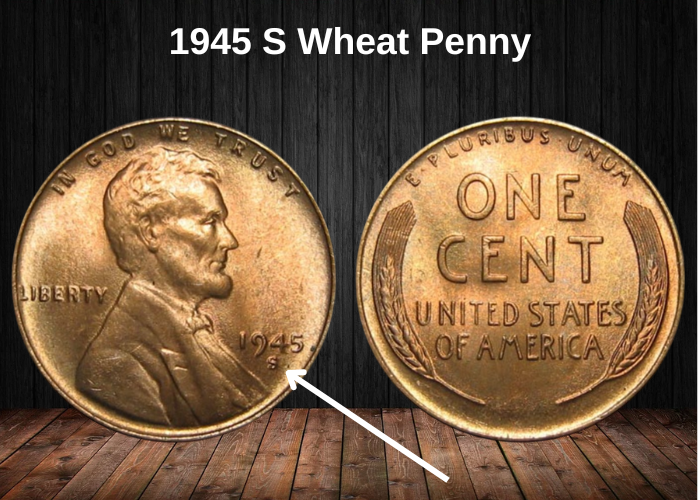
The San Francisco Mint produced the smallest mintage of 1945 Lincoln Wheat pennies, with 181,770,000 pieces released into circulation. While most of these coins, including those in mint state, are fairly affordable, there are still some that can fetch higher prices based on their condition and color.
The most expensive 1945 S Lincoln cents are those with an appealing red color, and their prices can vary depending on their grade:
- MS 63: Around $6.50
- MS 64: Around $10
- MS 65: Around $20
- MS 66: Between $23 and $35
- MS 67: Between $70 and $150
The highest-grade 1945 S red cents can be particularly hard to find. In 2015, a MS 67+ ranked specimen was sold for a significant $2,174 at auction.
For red-brown pennies, the prices are lower, typically ranging from $0.65 to $57, depending on the grade. Lastly, brown pennies with the 1945 date can be found at an even more affordable price, generally $0.55 to $47.
Rare 1945 Wheat Penny Error List
Clipped planchet
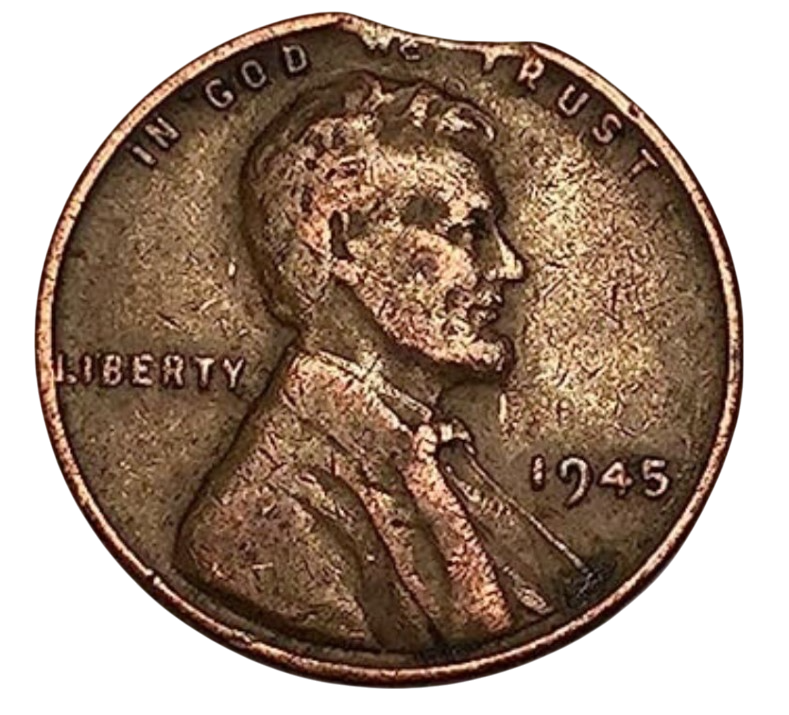
When a metal planchet is misaligned during the striking process, it can result in coins with a clipped edge. The value of these errors varies depending on the size of the clipped portion and the condition of the coin. Typically, these clipped coins are valued up to $100, though larger clips or those in better condition can be worth more.
Lamination flaw

In this type of error, the upper layer of the coin separates from its base during the minting process, resulting in noticeable bubbles or peeled lines on the surface. A 1945 Wheat Penny exhibiting this defect can be valued between $90 and $160, depending on the severity and condition of the error.
Doubled die
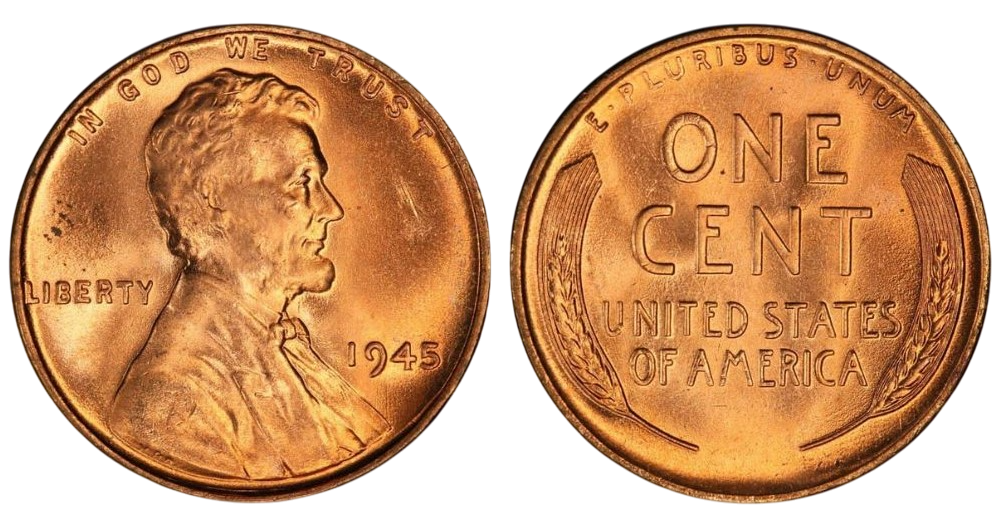
The 1945 pennies with doubled inscriptions or images are caused by a double strike, where the coin slightly shifts during the minting process. These coins are typically worth between $100 and $500, depending on their condition. However, coins in lower grades are often considered worthless because the subtle imperfection is hard to detect on worn-out surfaces.
Broad strike
A broad strike error happens when the coin is struck without a retaining collar, resulting in a wide coin with no edge design. While this error is not particularly rare among 1945 pennies, these coins are still collectible and can often be worth up to $200, depending on their condition.
Weight error
A weight error occurs when a coin is struck with the wrong amount of metal, making it heavier than usual. For example, a 1945 penny that weighs 0.11288 ounces (3.2 g) instead of the standard 0.10970 ounces (3.11 g) would be considered a weight error. These coins are rare, collectible, and can be worth a few dozen or even a hundred dollars, depending on their condition and demand.
Where to sell your penny?
Now that you know the value of your penny, you might be wondering where to sell it. Don’t worry: here’s a guide to some of the best online platforms where you can easily sell your coins, along with their advantages and disadvantages.
Discover the best platforms for selling coins online (pros and cons).
FAQ about the 1945 Wheat Penny
1. Why is the 1945 Wheat Penny important in U.S. coinage history?
The 1945 Wheat Penny is important because it represents the final year of the Wheat design before the switch to the Lincoln Memorial design in 1959. It was minted during the post-WWII period, a time when the United States was recovering from the war, and the economy was stabilizing. The 1945 cent is a continuation of the familiar Wheat design, which had been in production since 1909, making it a significant part of American coinage history.
2. What is the metal composition of the 1945 Wheat Penny?
The 1945 Wheat Penny is composed of:
- 95% copper
- 5% zinc
This composition remained consistent from 1909 through 1942 and then continued after the war, as there were no significant changes to the penny’s composition during the 1940s. The coin was made from copper that had previously been used for military purposes, such as spent shell casings.
3. How many 1945 Wheat Pennies were minted?
In total, more than 1.1 billion 1945 Wheat Pennies were minted across the three major U.S. Mint locations:
- Philadelphia (no mintmark): 1,122,470,000+
- Denver (D): 282,760,000+
- San Francisco (S): 277,120,000+
Given the large mintage numbers, the 1945 Wheat Penny is considered a common coin in circulated condition.
4. What is the value of a 1945 Wheat Penny today?
In general, the value of a 1945 Wheat Penny is as follows:
- Circulated condition: Generally worth around $0.05 to $0.25.
- Uncirculated condition: Can range from $1 to $10 for an MS-63 grade.
- Higher-grade uncirculated coins (MS-65 or above) can be worth $20 or more, depending on the overall quality and luster.
Special error coins, such as double die varieties or off-center strikes, may carry a premium.
5. Are there any notable varieties or errors for the 1945 Wheat Penny?
While the 1945 Wheat Penny is primarily known for its standard design, there are some notable error varieties, including:
- Double Die Obverse (DDO): These coins feature a doubled image, often on Lincoln’s lettering or his profile. Collectors often seek out coins with visible doubling, as they are worth more than typical 1945 Wheat Pennies.
- Off-center strikes or die cracks: These can be valuable depending on the severity of the error.
However, these varieties are less common and are often found in high-grade examples.
6. How does the 1945 Wheat Penny compare to the 1944 and 1946 Wheat Pennies?
- 1944: The 1944 Wheat Penny was minted during the post-war period, after the U.S. switched back to copper coinage. It is similar to the 1945 penny in terms of composition and design, but the 1944 Steel Penny error is unique to that year, which makes it more interesting to collectors than the 1945.
- 1946: The 1946 Wheat Penny is the first year after the 1945 coin, marking the beginning of the transition to the Lincoln Memorial design in 1959. While the 1945 coin is still part of the Wheat series, the 1946 penny is historically significant as it marked the beginning of the end of the Wheat series.
7. How can I identify a high-grade 1945 Wheat Penny?
To identify a high-grade 1945 Wheat Penny, collectors should look for:
- Sharp details: The wheat stalks, Lincoln’s profile, and the lettering on the obverse should be clearly defined without wear.
- Clean surfaces: No scratches, dings, or tarnish. The coin should have a smooth surface with little to no signs of circulation.
- Luster: An uncirculated coin will have a bright, reflective shine, while coins in higher grades will have more eye appeal.
Coins graded MS-65 or higher are considered premium examples, and they should show little to no abrasions.



















































